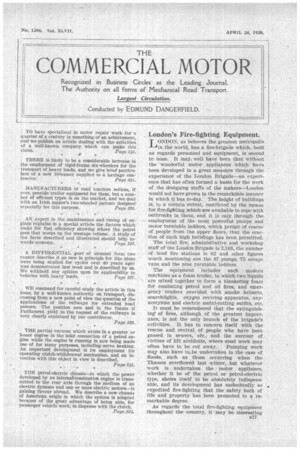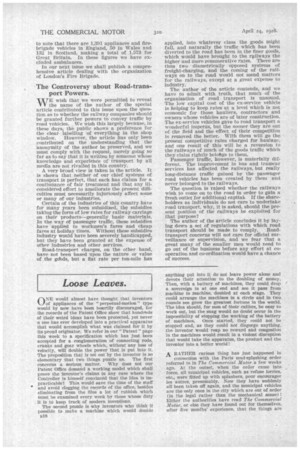London's Fire-fighting Equipment.
Page 43

Page 44

If you've noticed an error in this article please click here to report it so we can fix it.
• T .ONDON, as behoves the greatest metropolis -ILA in the world, has a fire-brigade which, both as regards personnel and equipment, is second to none. It may, well have been that without the wonderful motor appliances which have been developed in a great measure through the experience of the London Brigade—an experience that has often formed a basis for the work of the designing staffs of the makers—London would not have grown in the remarkable manner In which it has to-day. The height of buildings is, to a certain extent, restricted by the means for fire-fighting which are available to cope with outbreaks in them, and it is only through the employment of the most powerful pumps and motor turntable ladders, which permit of rescue of people from the upper floors, that the erection of such high buildings has been permitted.
The total fire, administrative and workshop staff of the London Brigade is 2,103, the number of land fire stations is 62 and other figures worth mentioning are the 87 pumps, 75 escape vans and the nine turntable ladders.
The equipment includes such modern machines as a foam tender, in which two liquids are mixed together to form a blanketing foam for combating petrol and oil fires, and emergency tenders provided with ,smoke helmets, searchlights, oxygen reviving apparatus, oxyacetylene and electric metal-cutting outfits, etc.
It must be remembered that the extinguishing of fires, although of the greatest importance, is not the only branch of the brigade's cctivities. It has to concern itself with the rescue and revival of people who have been gassed in sewers, etc., and the succour of victims of lift accidents, where steel work may often have to be cut away. Pumping work may also have to,be undertaken in the case of floods, such as those occurring when the Thames overflowed last winter, but whatever Work is undertaken the motor appliance, whether it be of the petrol or petrol-electric type, shows itself to be absolutely indispensable, and its development has undoubtedly so expedited fire-fighting that the safety both of life and property has been promoted to a remarkable degree.
As regards the total fire-fighting equipment throughout the country, it may be interesting
to note that there are 1,391 appliances and firebrigade vehicles in England, 50 in Wales and 132 in Scotland, making a total of 1,573 for Great Britain. In these figures we have excluded ambulances.
In our next issue we shall publish a comprehensive article dealing with the organization of London's Fire Brigade.
The Controversy about Road-transport Powers.
WE wish that we were permitted to reveal the name of the author of the special article contributed to this Issue upon the question as to whether the railway companies should be granted further powers to convey traffic by road vehicles. , We wish this largely because, in these. days, thb public shows a preference for the clear labelling of everything in the shop window. However, the article has only been contributed on the understanding that the anonymity of the author be preserved, and we must comply with the request, merely going so far as to say that it is written by someone whose knowledge and .experience of transport by all media are not rivalled in this country.
A very broad view is taken in the article. It is shown that neither of our chief systems of transport is perfect, that each has claims for a continuance of fair treatment and that any illconsidered effort to ameliorate the present difficulties must necessarily injuriously affect some or many of our industries.
Certain of the industries of this country have for many years been subsidized, the subsidies taking the form of low rates for railway carriage on their products—generally basic materials. In the way of passenger traffic, these subsidies have Applied to workmen's fares and cheap fares at holiday times. Without these subsidies Industry would have been severely handicapped, but they have been granted at the expense of other Industries and other services.
Road-transport charges, on the other hand, have not been based upon the nature or value of the riods, but a flat rate per ton-mile has applied, into whatever class the goods might fall, and naturally the traffic which has been diverted to the road has been in the finer goods, which would have brought to the railways the higher and more remunerative rates. There are thus two diametrically opposed systems of freight-charging, and the coming of the railways on to the road would not mend matters for the railways, except at a great expense to industry.
The author of the article contends, and we have to admit with truth, that much of the organization of road transport is unsound. The low capital cost of the ex-service vehicle is helping to keep rates at a level which is not economic for those hauliers, contractors and owners whose vehicles are of later construction. The ex-service vehicles gave to road transport a wonderful impetus, but the sooner they are out of the field and the effect of their competition is removed the better. With them will go the present competitive rates charged for haulage, and one result of this will be a reversion to the railways of much of the goods traffic which they claim rightly belongs to them.
Passenger traffic, however, is materially different. The improvement in bus and tramcar services has affected the railways, but really long-distance traffic gained by the passenger road vehicles has been created by them• and never belonged to the railways.
The question is raised whether the railways wish to come on to the road in order to gain a fresh outlet for additional capital: If the shareholders as individuals do not care to undertake road transport, why, it is asked, should the present position of the railways be exploited for that purpose?
The author of the article concludes it by laying down a set of regulations with which road transport should be made to comply. Roadtransport concerns will not care for official surveillance or supervision, and we fear that a great many of the smaller men would need to go out of the business before any effort at cooperation and co-ordination would have a chance of success.




















































































































